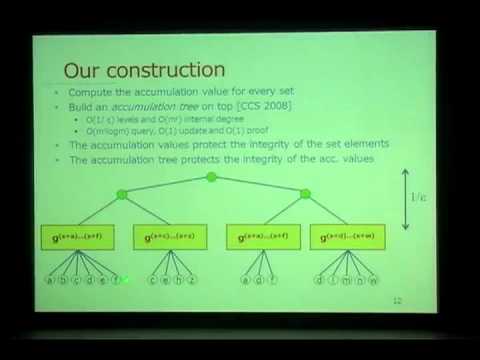Welcome to the resource topic for 2010/455
Title:
Optimal Verification of Operations on Dynamic Sets
Authors: Charalampos Papamanthou, Roberto Tamassia, Nikos Triandopoulos
Abstract:We study the verification of \emph{set operations} in the model of \emph{authenticated data structures}, namely the problem of cryptographically checking the correctness of outsourced set operations performed by an untrusted \emph{server} over a dynamic collection of sets that are owned (and updated) by a trusted \emph{source}. We present a new authenticated data structure scheme that allows any entity to \emph{publicly} verify the correctness of primitive sets operations such as \emph{intersection}, \emph{union}, \emph{subset} and \emph{set difference}. Based on a novel extension of the security properties of \emph{bilinear-map accumulators} as well as on a primitive called \emph{accumulation tree}, our authenticated data structure is the first to achieve \emph{optimal} verification and proof complexity (i.e., only proportional to the size of the query parameters and the answer), as well as \emph{optimal} update complexity (i.e., constant), and without bearing any extra asymptotic space overhead. Queries (i.e., constructing the proof) are also efficient, adding a \emph{logarithmic} overhead to the complexity needed to compute the actual answer. In contrast, existing schemes entail high communication and verification costs or high storage costs as they recompute the query over authentic data or precompute answers to all possible queries. % Applications of interest include efficient verification of keyword search and database queries. We base the security of our constructions on the \emph{bilinear q-strong Diffie-Hellman} assumption.
ePrint: https://eprint.iacr.org/2010/455
Talk: https://www.youtube.com/watch?v=pRhoiLFbU9Q
Slides: http://www.iacr.org/cryptodb/archive/2011/CRYPTO/presentation/03-1-Papamanthou.pdf
See all topics related to this paper.
Feel free to post resources that are related to this paper below.
Example resources include: implementations, explanation materials, talks, slides, links to previous discussions on other websites.
For more information, see the rules for Resource Topics .
